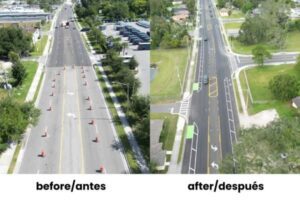Some Orange County roads are going on a diet, transforming local roadways to keep up with modern transportation needs. Local officials say the road diet strategy is for a safer roadway configuration.
Many of Orange County’s busiest thoroughfares were developed decades ago when cars ruled the road, but in recent years people have changed how they get around. Mass transit, bicycles, scooters and other micromobility devices have become more popular according to local officials, and this means more people travel along these busy roads rather than in the middle of them.
 In order to keep up with these shifts, Orange County Public Works is retrofitting certain roads to accommodate new methods of transportation while protecting a growing number of pedestrians by using a strategy known as a “road diet.”
In order to keep up with these shifts, Orange County Public Works is retrofitting certain roads to accommodate new methods of transportation while protecting a growing number of pedestrians by using a strategy known as a “road diet.”
A road diet strategy reconfigures existing roadways by reducing the number of vehicle lanes to create space for other uses such as bikes, wider sidewalks and pedestrian refuge islands, aiming to improve safety, efficiency and livability.
These strategic changes not only make the roadway more efficient, but also much safer. As an example, Orange County recently celebrated the completion of a road diet conversion on Rio Grande Avenue.
“The Rio Grande project showcases the opportunity to serve all modes of transportation such as vehicles, transit, bicycles and pedestrians,” said Humberto Castillero, manager, Orange County Traffic Engineering Division, “while also enhancing and improving the safety, mobility, connectivity and quality of life in our communities.”
According to the Federal Highway Administration, this type of road conversion can reduce the total number of crashes by 19-47 percent. Road diets also can be implemented relatively inexpensively when only pavement markings are modified, or in conjunction with reconstruction or overlay projects.
Benefits of road diet reconfigurations include:
- Reduction of rear-end and left-turn crashes due to the dedicated left-turn lane
- Reduced right-angle crashes as side street motorists cross three versus four travel lanes
- Fewer lanes for pedestrians to cross
- Opportunity to install pedestrian refuge islands, bicycle lanes, on-street parking or transit stops
- Traffic calming and more consistent speeds
- Creation of a “complete streets” environment that better accommodates the needs of all road users
For more on Orange County transportation safety improvements, go to Accelerated Transportation Safety Program.


